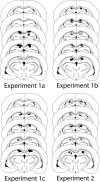Retrieval-mediated learning involving episodes requires synaptic plasticity in the hippocampus
- PMID: 21562278
- PMCID: PMC6703227
- DOI: 10.1523/JNEUROSCI.0295-11.2011
Retrieval-mediated learning involving episodes requires synaptic plasticity in the hippocampus
Abstract
A novel association can form between two memories even when the events to which they correspond are not physically present. For example, once an integrated memory has formed that binds the (when, where, and what) components of an event together, this memory can be triggered by one of its components, and updated with coincident information in the environment. The neural basis of this form of retrieval-mediated learning is unknown. Here, we show, for the first time, that NMDA receptors in the rat hippocampus are required for retrieval-mediated learning involving episodes, but not for the expression of such learning or for retrieval-mediated learning involving simple associations between the components of episodes. These findings provide a novel insight into learning processes that serve the desirable function of integrating stored information with new information, but whose operation might also provide a substrate for some of the cognitive symptoms of schizophrenia and Alzheimer's disease.
Figures




References
-
- Baddeley A, Conway MA, Aggleton JP. Episodic memory: new directions in research. Oxford: Oxford UP; 2002.
-
- Ball MJ, Hachinski V, Fox A, Kirshen AJ, Fisman M, Blume W, Kral VA, Fox H, Merskey H. A new definition of Alzheimer's disease: a hippocampal dementia. Lancet. 1985;325:14–16. - PubMed
-
- Bleuler E. Dementia praecox, or the group of schizophrenias (translated 1950 by Zinkin J) New York: International Universities; 1911.
-
- Dickinson A. Contemporary animal learning theory. Cambridge, UK: Cambridge UP; 1980.
-
- Doughty OJ, Lawrence VA, Al-Mousawi A, Ashaye K, Done DJ. Overinclusive thought and loosening of associations are not unique to schizophrenia and are produced in Alzheimer's dementia. Cogn Neuropsychiatry. 2010;14:149–164. - PubMed
Publication types
MeSH terms
Substances
Grants and funding
LinkOut - more resources
Full Text Sources
